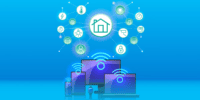Can IoT Enhance Healthcare and Remote Patient Monitoring

Are you curious about how IoT can revolutionize healthcare and remote patient monitoring? Look no further!
In this article, we will explore the role of IoT in healthcare, the benefits it brings to remote patient monitoring, the various IoT devices and sensors used in healthcare, and the importance of data security and privacy in this field.
Additionally, we will discuss the challenges and limitations of implementing IoT in healthcare and speculate on the future of IoT in remote patient monitoring.
Get ready to discover the exciting possibilities!
Key Takeaways
- IoT enhances healthcare delivery and revolutionizes remote patient monitoring.
- IoT devices enable real-time data collection and transmission, improving the quality of care and increasing efficiency.
- IoT allows for personalized treatment plans and preventive care strategies, leading to improved patient outcomes and engagement.
- Data security and privacy measures are crucial in IoT healthcare to address concerns and maintain patient trust.
The Role of IoT in Healthcare
The IoT plays a crucial role in enhancing healthcare and remote patient monitoring. With the advancement of technology, the impact on healthcare has been significant.
IoT devices such as wearables, smart sensors, and connected medical devices have revolutionized the way healthcare is delivered. These devices collect real-time data and transmit it to healthcare professionals, enabling them to monitor patients remotely. This has not only improved the quality of care but also increased efficiency in the healthcare system.
The role of technology in healthcare has also allowed for the development of personalized treatment plans and preventive care strategies. Through the use of IoT, healthcare providers can remotely monitor patients’ vital signs, track their medication adherence, and even detect early signs of health deterioration.
Ultimately, the integration of IoT in healthcare has the potential to save lives and improve the overall well-being of patients.
Benefits of IoT in Remote Patient Monitoring
You can experience improved patient outcomes through the use of IoT in remote monitoring. By leveraging IoT technology, healthcare providers can remotely monitor patients and collect real-time data, leading to numerous benefits in remote patient monitoring:
- Enhanced patient engagement: IoT devices enable patients to actively participate in their own care by providing them with access to their health data. Real-time monitoring allows patients to track their progress and make informed decisions about their health.
- Early detection of health issues: Continuous monitoring through IoT devices enables healthcare professionals to detect potential health problems at an early stage. Timely intervention can prevent complications, reduce hospitalizations, and improve patient outcomes.
- Efficient healthcare delivery: IoT-enabled remote patient monitoring reduces the need for frequent hospital visits, saving time and resources for both patients and healthcare providers. Healthcare professionals can remotely monitor multiple patients simultaneously, improving efficiency and accessibility of care.
Overall, the impact of IoT in healthcare and remote patient monitoring is substantial, providing better patient outcomes, increased patient engagement, and more efficient healthcare delivery.
IoT Devices and Sensors for Healthcare
Using IoT devices and sensors can greatly improve the quality of healthcare by providing real-time data and insights. Wearable technology and telemedicine applications play a crucial role in this transformation. Wearable devices, such as smartwatches and fitness trackers, can monitor vital signs and activity levels, providing valuable information about a patient’s health. Telemedicine applications enable remote consultations, allowing patients to connect with healthcare professionals from the comfort of their homes. This table highlights some of the key benefits of using IoT devices and sensors in healthcare:
| Benefits of IoT Devices and Sensors in Healthcare |
|---|
| Real-time monitoring of vital signs |
| Early detection of health issues |
| Improved patient engagement |
| Enhanced remote patient monitoring |
Data Security and Privacy in IoT Healthcare
Ensure that your data is secure and your privacy is protected when using IoT devices and sensors in healthcare. With the increasing use of IoT in healthcare, it is crucial to prioritize data security and privacy to prevent data breaches and ensure regulatory compliance.
Here are some important steps to consider:
- Implement strong encryption protocols to protect data transmission and storage.
- Regularly update and patch IoT devices to address vulnerabilities and protect against cyber threats.
- Follow regulatory guidelines and standards, such as HIPAA, to ensure compliance and safeguard patient information.
By taking these measures, you can minimize the risk of data breaches, protect sensitive healthcare information, and maintain the trust of patients.
Challenges and Limitations of IoT in Healthcare
When considering the implementation of IoT in healthcare, there are several key challenges and limitations to be aware of.
First, data security concerns are a major consideration, as the sensitive patient information that is collected and transmitted must be protected from unauthorized access.
Additionally, integration with existing systems can be complex, requiring careful planning and coordination to ensure seamless communication and compatibility.
Lastly, the reliability of IoT devices is crucial, as any failures or malfunctions could have detrimental effects on patient care and safety.
Data Security Concerns
To protect sensitive patient information, it is important to address data security concerns when implementing IoT in healthcare and remote patient monitoring. The interconnected nature of IoT devices poses challenges for data security. Here are some key points to consider:
- Interoperability issues: Ensuring seamless communication and data exchange can be complex due to multiple devices and systems involved. Careful management of interoperability between different IoT devices and platforms is necessary to prevent vulnerabilities and breaches.
- Regulatory compliance: Healthcare organizations must comply with strict regulations such as HIPAA (Health Insurance Portability and Accountability Act) to safeguard patient data. IoT implementation should align with these regulations to ensure data security and privacy.
- Encryption and authentication: Robust encryption protocols and strong authentication mechanisms are crucial to prevent unauthorized access to patient data. It is important to integrate secure protocols and authentication methods into IoT devices and systems.
Integration With Existing Systems
Now that we’ve addressed the data security concerns, let’s talk about another challenge when it comes to integrating IoT in healthcare: integration with existing systems. This is a crucial step in successfully implementing IoT technology in healthcare settings. The integration challenges arise due to the interoperability issues between different devices and software systems.
To give you a better understanding, here’s a table that highlights some common integration challenges and interoperability issues faced in healthcare:
| Integration Challenges | Interoperability Issues | Emotional Response |
|---|---|---|
| Legacy Systems | Incompatibility | Frustration |
| Data Standardization | Lack of Common Standards | Confusion |
| Scalability | Limited Device Support | Overwhelm |
| Security and Privacy | Vulnerabilities | Concern |
As you can see, these challenges and issues can evoke various emotions, ranging from frustration to concern. Overcoming these obstacles is crucial to ensure seamless integration and maximize the benefits of IoT in healthcare.
Reliability of Iot Devices
Make sure you choose reliable devices for seamless integration and optimal performance. When it comes to IoT devices in healthcare, reliability is crucial. There are several reliability challenges and connectivity issues that you need to be aware of.
Here are some things to consider:
- Device compatibility: Ensure that the IoT devices you choose are compatible with your existing systems to avoid any integration issues.
- Data security: Look for devices that have robust security measures in place to protect patient data and prevent unauthorized access.
- Network reliability: Check the connectivity options of the devices to ensure they can maintain a stable connection, even in areas with poor network coverage.
Future of IoT in Remote Patient Monitoring
You can see the potential of IoT in remote patient monitoring as it continues to evolve and shape the future of healthcare. The impact of IoT on healthcare delivery is immense, especially in the field of telemedicine.
IoT applications in telemedicine allow healthcare professionals to remotely monitor patients and provide timely interventions. With IoT devices, patients can track their vital signs, such as heart rate, blood pressure, and glucose levels, from the comfort of their own homes. This real-time data enables doctors to make accurate diagnoses, adjust treatment plans, and prevent potential complications.
Additionally, IoT technology facilitates better communication between patients and healthcare providers, ensuring that patients receive the necessary care, even from a distance.
The future of remote patient monitoring with IoT holds great promise in improving healthcare accessibility and quality for all.
Frequently Asked Questions
How Does Iot Technology Improve Healthcare Outcomes for Patients in Remote Areas?
In remote areas, IoT technology improves healthcare outcomes by enhancing patient care and improving healthcare access. By connecting devices and collecting data, healthcare providers can monitor patients remotely and provide timely interventions.
What Are the Potential Risks Associated With Using Iot Devices and Sensors in Healthcare?
Potential risks associated with using IoT devices in healthcare include data breaches, privacy concerns, and the possibility of device malfunctions. Ethical considerations arise from the need to balance patient autonomy and safety.
How Does Data Security and Privacy Concerns Affect the Adoption of Iot in Healthcare?
Data security and privacy concerns play a significant role in the adoption of IoT in healthcare. It’s important to address these concerns to ensure the safe and secure use of IoT devices and sensors.
What Are the Main Challenges Faced in Implementing Iot in Remote Patient Monitoring?
The main challenges you face in implementing IoT for remote patient monitoring include integrating IoT devices into healthcare delivery, ensuring data security, maintaining connectivity, and addressing privacy concerns.
How Is the Future of Iot Shaping up in Terms of Remote Patient Monitoring and Healthcare Delivery?
In the future, IoT will greatly shape remote patient monitoring and healthcare delivery. It will bring about new trends and have a significant impact on how healthcare is delivered to patients.






